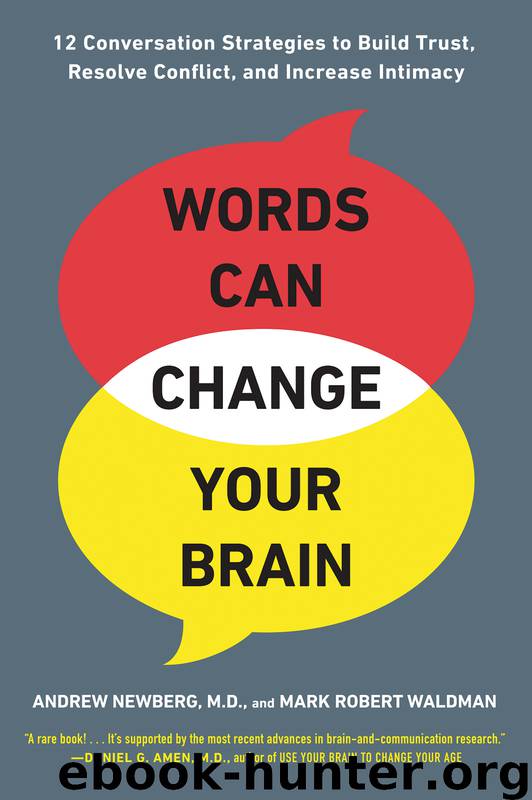Words Can Change Your Brain by Andrew Newberg

Author:Andrew Newberg
Language: eng
Format: epub
Publisher: Penguin Group US
Published: 2012-05-23T16:00:00+00:00
Step 7: Observe Nonverbal Cues
“Keep your eyes on the ball.” It’s an expression used in sports and often applied to business, but when it comes to interpersonal relationships, it’s essential to keep your eyes on the individual you are conversing with in order to discern the many nonverbal messages we constantly send to others. However, this does not mean that you should gaze unceasingly at the other person—that could feel invasive—but if you maintain softness in your eyes, generated by a pleasant memory, the other person won’t want to take their eyes off you!
Eye contact stimulates the social-network circuits in your brain.28 It decreases the stress chemical cortisol, and it increases oxytocin, a neurochemical that enhances empathy, social cooperation, and positive communication.29
Most people can recognize the seven basic facial expressions—anger, fear, sadness, disgust, surprise, contempt, and happiness—even though they remain on a person’s face for just a few seconds. But as Ekman explains, you need to stay completely focused, making sure that you aren’t distracted by your inner thoughts.30
If a person wants to conceal a feeling—out of embarrassment, discomfort, or the desire to deceive—the true expression might only appear for a quarter of a second. Reading micro-expressions is not essential for effective communication; it simply gives you an edge. Nor will your impressions necessarily be accurate. You’ll have to look for additional clues, and then ask the person if you are correct. But there’s a problem: when you do this, the other person can feel violated. It’s very disturbing when you discover that someone can read your mind.
Micro-expressions can only tell you that a true emotion is hidden, but it won’t tell you why. Nor will it tell you whether the person is consciously or unconsciously concealing it. To ferret out these important bits of information, you’ll have to talk more deeply with your partner.
When you learn how to read micro-expressions, says Ekman, “it gives you an edge in business because it allows you to communicate more effectively with business partners.” We suggest that you visit Ekman’s website (www.paulekman.com) to see how well you can detect micro-expressions using the micro-expression training tool. Ekman is currently using his research on facial expressions to help people cultivate emotional balance.
Download
This site does not store any files on its server. We only index and link to content provided by other sites. Please contact the content providers to delete copyright contents if any and email us, we'll remove relevant links or contents immediately.
| Codependency | Conflict Management |
| Dating | Divorce |
| Friendship | Interpersonal Relations |
| Love & Loss | Love & Romance |
| Marriage | Mate Seeking |
The 5 Love Languages: The Secret to Love That Lasts by Gary Chapman(9610)
Doing It: Let's Talk About Sex... by Hannah Witton(9200)
Should I Stay or Should I Go? by Ramani Durvasula(7574)
The Road Less Traveled by M. Scott Peck(7525)
The Lost Art of Listening by Michael P. Nichols(7413)
Daring Greatly by Brene Brown(6451)
Beartown by Fredrik Backman(5611)
We Need to Talk by Celeste Headlee(5547)
Men In Love by Nancy Friday(5163)
The Rules Do Not Apply by Ariel Levy(4871)
The State of Affairs by Esther Perel(4647)
How To Win Friends and Influence People by Dale Carnegie(4449)
Reflections Of A Man by Mr. Amari Soul(4243)
Pillow Thoughts by Courtney Peppernell(4215)
The Ethical Slut by Janet W. Hardy(4178)
Algedonic by r.h. Sin(4016)
He's Just Not That Into You by Greg Behrendt & Liz Tuccillo(3835)
I Love You But I Don't Trust You by Mira Kirshenbaum(3812)
Surrounded by Idiots by Thomas Erikson(3800)
